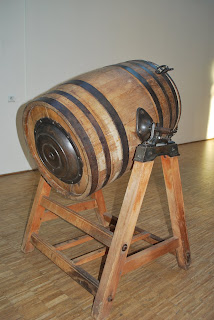
 I was born into an urban environment at Christchurch in 1955. When I was three and a half my parents moved to the outskirts of Bishopdale, which eventually became known as Casebrook. At that stage it was a new subdivision of what had been dairy farms, practically rural. Distant members of the family lived in, what seemed to me, far-flung suburbs of Christchurch and my grandfather and uncle had spent some time working as farm hands for money early in their lives (cutting cocksfoot and bailing hay)so there was a smattering of things rural in my early years. I had a basic appreciation of farming and the equipment because you didn't need to travel far to see them in action in those days.
I was born into an urban environment at Christchurch in 1955. When I was three and a half my parents moved to the outskirts of Bishopdale, which eventually became known as Casebrook. At that stage it was a new subdivision of what had been dairy farms, practically rural. Distant members of the family lived in, what seemed to me, far-flung suburbs of Christchurch and my grandfather and uncle had spent some time working as farm hands for money early in their lives (cutting cocksfoot and bailing hay)so there was a smattering of things rural in my early years. I had a basic appreciation of farming and the equipment because you didn't need to travel far to see them in action in those days.Chartres has a museum of farm equipment. It is a fairly recent building (1990)on a site that was used to repair old steam locomotives and is dedicated to sciences and techniques of agriculture.
 There's an important collection of old machines and tools which date from 1800 - 1950 and it holds small exhibitions as well as displays such as environmental issues and how to feed the world's burgeoning population.
There's an important collection of old machines and tools which date from 1800 - 1950 and it holds small exhibitions as well as displays such as environmental issues and how to feed the world's burgeoning population.COMPA, as the museum/centre is known, conserves, teaches and highlights issues, in particular the relationship between urban and rural environments.
 The brochure says there's a 20min audiovisual presentation but there was no sign of iton the cold and quiet day we visited. Some of the info displays were a bit tired or damaged which didn't give a good impression.
The brochure says there's a 20min audiovisual presentation but there was no sign of iton the cold and quiet day we visited. Some of the info displays were a bit tired or damaged which didn't give a good impression. However, the collection of old tractors, ploughs and threshing machines is quite good. Most of them are French, most from the Beauce region (the main grain producing area in France, where Jean-Claude lives). There was a massive American tractor (Waterloo Boy 1916) and a Canadian one (Sawyer Massey 1910). I looked for brand names that might be familiar to me. Massey featured, not Massey-Fergusson, there were Renaults of course. I couldn't identify anything like the traction engines I had seen in my childhood but the farms of France are quite different to those in NZ; the sizes, development, history, suppliers.
However, the collection of old tractors, ploughs and threshing machines is quite good. Most of them are French, most from the Beauce region (the main grain producing area in France, where Jean-Claude lives). There was a massive American tractor (Waterloo Boy 1916) and a Canadian one (Sawyer Massey 1910). I looked for brand names that might be familiar to me. Massey featured, not Massey-Fergusson, there were Renaults of course. I couldn't identify anything like the traction engines I had seen in my childhood but the farms of France are quite different to those in NZ; the sizes, development, history, suppliers.There was a very interesting example of a mobile hut that used to be used by shepherds. This little cabin hardly big enough for a man to lie down in supplied shelter for the shepherd out in the fields. They lived in them-not very salubriously. Homes on wheels, the shepherds could move them as the flocks of sheep moved; the equivalent, I suppose, of a cowboy camping out with his herd of cattle.
There was also an example of a butter churn; same sort of tool my grandmother knew how to use in her youth, along with ploughs for different areas and crops and tasks, seed-sowers and threshers. There was a nice scale model of a steam engine/tractor which is similar to a working model JC has at his house.

Some models of typical French farm layouts of a century gone by were very interesting to me, entirely different architecture and arrangement to those of NZ. Rather romantic, some produced both animals and grains but the emphasis here was cereal crops. These models showed great details but taking photos was rather difficult because of reflections on the glass.
This museum near the centre of Chartres is worth a stop off if you are into tractors or the weather isn't pleasant.













0 comments:
Post a Comment
I welcome your comments, contributions and feedback.